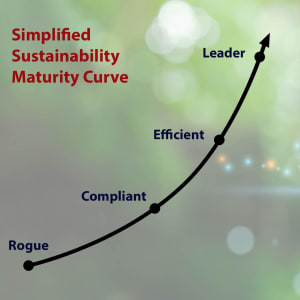Though a hot topic today, replete with full blow educational programs delivering sustainability-trained graduates, the field of sustainability has been maturing over decades. Sometimes under the rubric of Environmental Health and Safety, now often touted as ESG (Environment, Social and Governance), we like the umbrella term of sustainability for its ease-of-use. As the field grows, so do the many demands of both society and industry, and so grows the call for accountability across its many pillars.
The growth of sustainability within an organization is often characterized as a curve, starting at the lower left, curving ever-upward to the right. There are lots variations on the theme, but I’ve simplified the concept here:
 At the bottom left we would find a “rogue” state, an organization oblivious to its impacts on the environment, on its workers, on the communities where it operates. Though these organizations exist, they don’t tend to get very large, depending on their locale, simply because they inevitably have to contend with legislation – environmental and labor for starters.
At the bottom left we would find a “rogue” state, an organization oblivious to its impacts on the environment, on its workers, on the communities where it operates. Though these organizations exist, they don’t tend to get very large, depending on their locale, simply because they inevitably have to contend with legislation – environmental and labor for starters.
Thus, the next stage on our curve is typically known as “compliant,” where an organization follows not only the rules and regulations set down by applicable governments, but also adheres to industry standards. In many cases these standards have been developed over decades and continue to evolve. Industry standards relevant to sustainability include ISO 14001 (managing environmental impacts) and, specific to the handling of electronics at end of life, the Sustainable Electronics Reuse & Recycling (R2) Standard. The more “mature” an organization is, the more it will choose to do business only with other businesses that are compliant with those standards important to their industry. This insistence elevates the business and helps reduce the liability represented by a lack of accountability. Typically, industry standards require that companies are audited and seen to be in compliance before they can be certified to a specific standard.
As companies continue to embrace the principles of sustainability, they look to reduce their energy use, their general consumption and their waste. This third stage could be called “optimization” and the resulting business is significantly more “efficient.”
But companies that are striving to truly make a difference, to reduce the greenhouse gas emissions implicated in climate change, are going beyond mere efficiency. They are holding themselves and their value chains accountable across a broad range of parameters. And these “leaders” are tackling the 800-pound gorilla of emissions reporting commonly referred to as Scope 3 Emissions. To truly reduce emissions globally – and we are one globe, one atmosphere, after all – companies need to get an actual handle on the emissions being generated on their behalf both upstream and downstream of their core business. To this end, illumynt is actively working to quantify the Scope 3 emissions that can be avoided by finding new lives for devices and components.
Wherever your organization is on this maturity curve, furthering your efforts to be more sustainable and accountable will likely further your relationships with other organizations as well as with your own stakeholders.
Be sure to read my continuing blog series as I discuss all things related to sustainable electronics.




